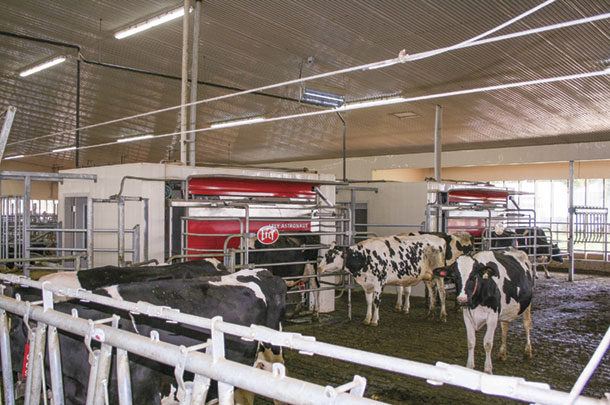Labor savings is a primary goal of automatic milking system barn design. Excellent cow comfort and welfare also provide for healthy and productive cows. The investment in technology of robotic milking system and precision dairy management is intended to be paid for by the assumed labor savings achieved over the service life of the equipment and technology. While there is a reduction in physical milking labor, some of that labor shifts toward dairy herd management and data analysis.
Designing the new or retrofit automatic milking system barn for efficient workflows for the people can be predicted with planning and achieve the desired reduction in labor costs. The common daily workflow tasks performed in the automatic milking system barn include fetching cows, cleaning and maintaining stall beds and manure alleys, transition and maternity cow management, cleaning the system room and collecting waste milk that may be fed to calves.
Research conducted by 4dBarn found there is a wide variation in labor to perform the routine tasks in automatic milking system barns of all sizes and types of layouts. Farms with more than three units were more labor-efficient than farms with two or fewer units. In a farm with two automatic milking system units, there was a 28-minute-per-day savings between the farms with highest labor used on the farm and the farms with average labor used.
For a farm with four units, there was 1.5-hours-per-day labor savings difference. Whether this is paid labor or unpaid labor, that difference can add up over time. On smaller farms, the owner has a little extra time each day to perform other tasks. On larger farms, the decreased labor need can be a 20% lower annual labor cost for managing the automatic milking system units.
The design process should spend time to discuss and develop the farmer’s management plan. The management plan may not be well defined because it is a new experience for the farmer to work in an automatic milking system barn. Design decisions on the barn design, layout and features are made to allow the farmer to implement their unique management plan and create a barn that will be cow-comfortable and save labor.
How do I use the new or retrofit automatic milking system barn? This is the basic question asked when developing a workflow management plan that focuses on the labor savings in the barn design. It identifies the features that can be integrated into the barn design to make the work routines efficient. Combining appropriate multitasking into the workflow routines can save time by following the same path to achieve two different tasks. For example, multitasking to fetch cows and clean stall beds is better than separating fetching workflow from stall maintenance workflow.
Design with labor savings in mind
There are several guiding principles and design features that can be integrated into an automatic milking system barn design to achieve labor savings. These include:
1. Cow comfort
Cow comfort in the barn design is important because if cows are comfortable and healthy, they are less likely to be fetch cows. The fewer fetch cows there are, the less labor is required. When designing a retrofit automatic milking system design, the pen space should be looked at critically to make sure there are no major compromises on stall length, alley widths and feed space that will limit the comfort of the cow space to rest, eat and walk.
2. Pen size
As the number of cows per unit increases, so do the number of fetch cows and labor needs. Many new automatic milking system designs place two to three units in a pen rather than a single system per pen. Research has found increased milk harvested per automatic milking system and increased labor efficiency. Many farms try to get an average of three milking visits per cow per day, thus improving milk production per cow. A pen dedicated to fresh cows that has 24-hour access to an automatic milking system unit can help improve cow health and increase the number of daily visits. This can help increase the peak milk production and reduce labor needed to manage cows in this period of their lactation.
3. System location and orientation
The orientation of the automatic milking system units may or may not allow the implementation of certain management decisions. For example, an orientation that allows controlled access to a footbath is often missing in many designs. Additional labor is then needed to move cows through a remote footbath location. Adequate space in the entry area to the system can help timid cows navigate to an available system more easily. A cow traffic pattern that keeps cows entering the system separate from the cows exiting the unit can reduce congestion in the system entry area.
4. Fetch pen
A fetch pen allows the farmer to collect a small group of fetch cows, saving labor as compared to bringing individual cows one at a time to the unit. Strategically located gates near the system entry can help train heifers. A split-entry pen that allows equal access to either fetch pen cows or cows in the main group to access the system is preferred to utilize the unit more efficiently and reduces time for people to wait for the fetch cows to be milked.
5. Centralize cow handling area
A central handling area with appropriate equipment not only saves money compared to duplicate handling areas, it also reduces travel distances for cows to be moved for easy and quick treatments when needed. This design decision requires a change in feed flow with outside feed traffic alleys rather than a central feed traffic alley.
6. One person can perform a task alone
A complete automatic milking system barn design should include a gating plan. This includes detailed information on the locations and specific types of gates necessary to allow one person to get the job done quickly and easily. There is a whole new terminology to learn when describing the various styles of gates, other than swing gates, that might be used in automatic milking system barn design. One-way gates, saloon gates, finger gates, “Texas” gates, lifting gates, pipe gates, drop gates, sort gates and smart gates all may be part of the gating plan.
Workflow simulations can also be developed as part of the final design to help the cow manager understand the cow flow and train people on how workflow tasks will be performed after the barn is built. Tasks like fetching cows, moving a cow to trim a hoof, moving a cow from a maternity to fresh pen can all be simulated with the automatic milking system barn design and gating plan.
References omitted but are available upon request by sending an email to the editor.







